Mark Morris directs and choreographs Handel’s Acis and Galatea for Lincoln Center’s Mostly Mozart Festival.
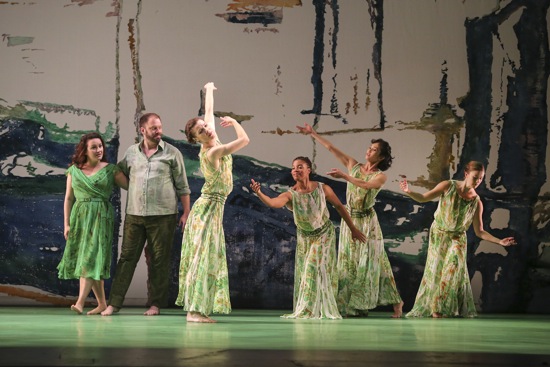
Yulia Van Doren (Galatea) and Thomas Cooley (Acis) with Mark Morris dancers (L to R) Laurel Lynch, Michelle Yard, Maile Okamura, and Rita Donahue in Handel’s Acis and Galatea. Photo: Richard Termine/Lincoln Center
It is beguiling to imagine George Frideric Handel’s pastoral opera Acis and Galatea receiving its first performance at the Duke of Chandos’s mansion on the terrace overlooking the gardens and their newly installed fountain. If the part about the terrace were true, guests at this 1718 debut would have heard the sounds produced seven musicians in the Duke’s employ and the five singers (who voiced their own roles and doubled as the chorus) floating on summer air.
The view of the fountain would have added greatly to the atmosphere of John Gay’s libretto too. In the tale, drawn from Ovid’s Metamorphosis, the burgeoning love between Acis and Galatea is threatened by the Cyclops Polyphemus—a creature of huge size and huge appetites, who wants the nymph for himself. Spurned by her, he hurls a boulder at Acis. Galatea, reminded of her magic powers, transforms the lover she mourns into a stream that will flow forever. (Alexander Pope and John Hughes had a hand in the text, and some bits may have been borrowed from John Dryden’s translation of Ovid.)
The little opera’s history itself flowed along a tributary with many bends and streamlets. Additions and subtractions (not all of them sanctioned by Handel) continued until 1739. In 1788, for a Viennese patron, Wolfgang Amadeus Mozart re-orchestrated Acis and Galatea for production in a theater—augmentingthe chorus and orchestra. Clarinets, which Mozart loved, replaced recorders and took over some prominent oboe parts.
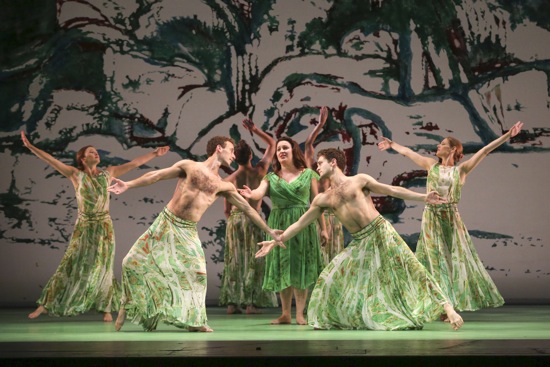
Galatea sings of her love to (L to R) Rita Donohue, Aaron Loux, Benjamin Freedman, and Jenn Weddel. Photo: Richard Termine/Lincoln Center
Handel respectfully revised by Mozart. . .what’s not to love? And it’s understandable that Mark Morris, that most musical of choreographers, would love Acis and Galatea enough to take on the job of directing and choreographing it. The music is gorgeous—limpid, rich in contrapuntal currents and fanciful ideas (such as the woodwinds imitating the birds that Galatea orders to cease warbling so she can think more clearly about her lover). The plot is simple, and the word “happy” is repeated many times under an apparently cloudless Act I sky. However, with the second-act entrance of Polyphemus, the verdant little world gets considerably darker. It’s also in Act II that Morris makes more use of his bawdy humor.
The production that was performed at Lincoln Center as part of the annual Mostly Mozart Festival is a lovely one. The three backdrops by Adrianne Lobel (based on her own paintings) present enigmatically abstract landscapes. These rise and fall behind and in front of one another—forming transparent layers, and, aided by Michael Chybowski’s fine lighting, they themselves change color.
The first one, with its billowy white shapes, green splashes, and touches of red, influenced Isaac Mizrahi’s costumes for the Mark Morris Dance Group members. Men and women alike wear long, full chiffon skirts, lightly mottled with those shades, as are the women’s sleeveless tops. Polyphemus (baritone Douglas Williams) is costumed as a dandy in a suit that’s similarly tinted (although he and the other singers are barefoot). Enigmatic in this context are the more neutral outfits worn by the remaining three; those for Acis (tenor Thomas Cooley) and his friend Damon (tenor Isaiah Bell) are kin to the leisure attire a guy might wear to a barbecue, and soprano Yulia Van Doren’s emerald-green dress looks like an expertly cut cousin of those suitable-for-all-occasions items you could pack for a trip. The members of the Philharmonia Chorale are in the pit, along with the musicians of the Philharmonia Baroque Orchestra under the baton of Nicholas McGegan.
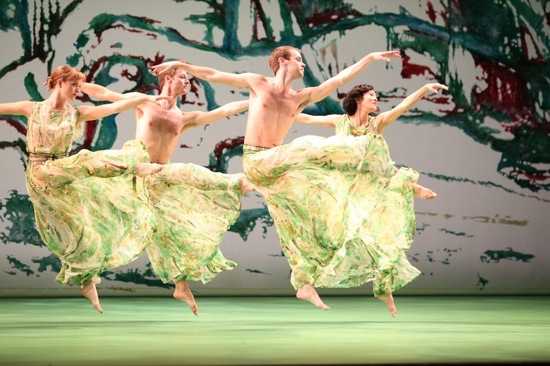
The Mark Morris Dance Group members in Acis and Galatea. (L to R): Chelsea Lynn Acree, Billy Smith, Noah Vinson, and Maile Okamura. Photo: Ken Friedman
The singers are excellent, and what Morris has achieved in the way of integrating them with the dancers is wonderfully revealing—responding to the music’s textures, the words, the drama, and Ovid’s theme. I introduced with water metaphors a couple of paragraphs ago because I think Morris does this in Acis and Galatea. Much of the imagery in his choreography seems to allude both to Handel’s rippling, bubbling, musical pour and to the stream that Acis becomes. These nymphs and shepherds with their flowing garments make their first entrance gradually in squads of four—running in and curving onto a diagonal, reaching toward a destination; turning to face upstage, both arms raised, and hastening there; then exiting and immediately returning. When the chorus bursts into song, the dancers add a turn, a hop and a soft leap to the pattern. Out of these coming-and-going currents, Morris builds a repeating, four-part contrapuntal picture that’s both formal in structure and free as water on the dancers’ bodies. And these dancers are marvels at capturing the music’s lyricism yet remaining earthy.
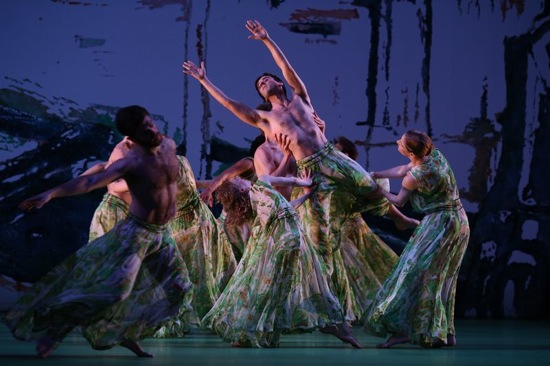
Handelian turbulence in Acis and Galatea. Members of the Mark Morris Dance Group. Photo: Ken Friedman
“Harmless, merry, free and gay,/ Dance and sport the hours away,” sings the chorus. “For us the zephyr blows,/For us distills the dew. . . .” But in this bucolic nymphs-and-shepherds setting, the dancers are also the companions of Acis and Galatea and at times (very subtly, except in one comic moment) their sheep. That is, they tend to flock. Sometimes they accompany the love-besotted Acis and/or Galatea solicitously, as if to leave them to their own devices might lead them to fall off a cliff; sometimes they just follow along. The lovers keep losing track of each other. During Acis’s “Where shall I seek the charming fair?” Michelle Yard and Aaron Loux shepherd them across the stage. Almost immediately, Galatea wanders through again, this time with three attendants; Acis follows suit. The next time she passes by, four dancers accompany her; he receives the same attention. No wonder Damon comes to advise Acis to tend to his flock and curb his passion for a while.
Fifteen of the dancers form contrapuntal trios to depict over and over the forces that separate the lovers. Each threesome begins intertwined; then the middle person, arms spread, pushes between the other two. Briefly the three bend side to side together, before the central figure turns and pushes the other two apart. Reconnecting, they begin again. This happens in Act II, as I recall, right after the overture that begins like a gentle ramble, turns spirited and assertive, and then starts asking dark questions. Trios crossing the stage also mimic and anticipate Polyphemus’s entry: two dancers lift one and move his/her legs in giant strides through the musical air.
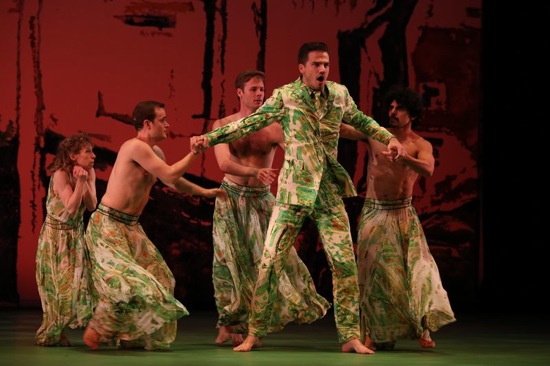
Douglas Williams as Polyphemus in Acis and Galatea, with (L to R) Lauren Grant, Dallas McMurray, Billy Smith, and Domingo Estrada Jr. Photo: Ken Friedman
Baritone Williams—long-limbed, mobile, and dapper—sings the recitative that begins, “I rage, I melt, I burn!” with fierce gusto and starts ordering the dancers around. As they circle him docilely, he embarks on the lubricious “O ruddier than the cherry,/ O sweeter than the berry,/ O nymph more bright/ Than moonshine night,/ Like kidlings blithe and merry!”—swatting this one, shoving that one, stroking a flank, and pinching a startled man’s nipples; Lauren Grant faints dead away when he demonstrates his “capacious mouth.” They form a couch for him and Maile Okamura places a helpful hand on his crotch. Damon attempts to give Polyphemus a lesson in gentleness, but although the villain copies his gestures, the advice isn’t heeded. He loses his temper and launches Okamura as Ovid’s boulder; she’s passed from hand to hand in slow motion flight until she knocks Acis to the ground and lies inert beside him.
But this is a story about love, and the dancers also illustrate that aspect of Handel’s ravishing songs, such as the one that Acis sings in Act I (“Love in her eyes sits playing,/ And sheds delicious death;/ Love on her lips is straying/ And warbling in her breath!”). In response, Loux and Chelsea Lynn Acree dance sweetly together, and other pairs join them. In a recurrent motif, couples cross the stage with a polonaise step, bending together, then apart, as they go. There are lovers among this flock; partners lift their sweethearts, and in their suspended turns and floating leaps, they catch each other and are caught.
Morris, as always, makes sure the audience gets to know the dancers he loves. So when Acis is screwing up his courage to confront Polyphemus (“Love sounds th’alarm,/ And fear is a flying!/ When beauty’s the prize,/ What mortal fears dying?”), Morris sends Laurel Lynch marching in with a brave display of dancing—a flipped kick, the slow lift of a leg, the jut of a hip. . . .The same solo is repeated until eight men, one by one, or two by two, have performed the brief exhortation.
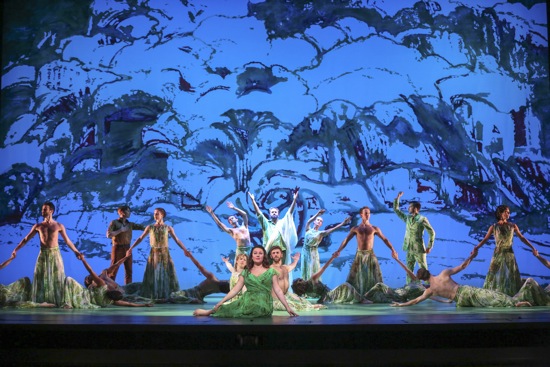
The happy ending of Acis and Galatea. Amid Mark Morris’s dancers: Yulia Van Doren (foreground), Thomas Cooley (center rear), Isaiah Bell (rear left), and Douglas Williams (rear right). Photo: Richard Termine/Lincoln Center
Near the end, while Galatea mourns, all the backdrops are lifted and the rear wall of the stage momentarily glows dark orange. But the first pastoral painting drops down again, and by the time the chorus is singing, “Galatea, dry thy tears,/ Acis now a god appears!” the dancers are forming couples, meeting and parting over and over, leaping and circling, lifting their partners. Her lover, crowned and robed, has become a river. Love flows on.
.

Have to say the photos of those costumes make them look extremely vapid, but from Deborah’s eloquent description, they are nothing of the kind. Wish I could see this, probably should have gone down to Berkeley to see it at Zellerbach when it premiered there. Thanks Deborah, again, and again, for putting me in the theater with you.
The costumes are actually quite wonderful, though from the photo above, Acis & Galatea’s outfits seem to have changed from the Boston performances, when their outfits were cut from the same cloth as the dancers’ and Polyphemus’s (see his wonderful suit & tie). I don’t know why that change has taken place. Mizrahi creates the sense of pastoral with a kind of post-Impressionist print design, & it works handsomely to create a seamless web of singers & dancers. Morris’s A & G is an exquisite comic baroque through-danced opera to stand alongside his tragic baroque masterpiece, Dido–and it’s interesting how much humor Dido has and how much pathos there is in A & G.
As Deborah suggested, he does more with male-female partnering in this work than he ever has, previously professing that the gender of dancers doesn’t matter. In A & G it definitely does matter, to splendid effect. I’ll have more to say on this in my review of A & G, forthcoming in the Fall Ballet Review.